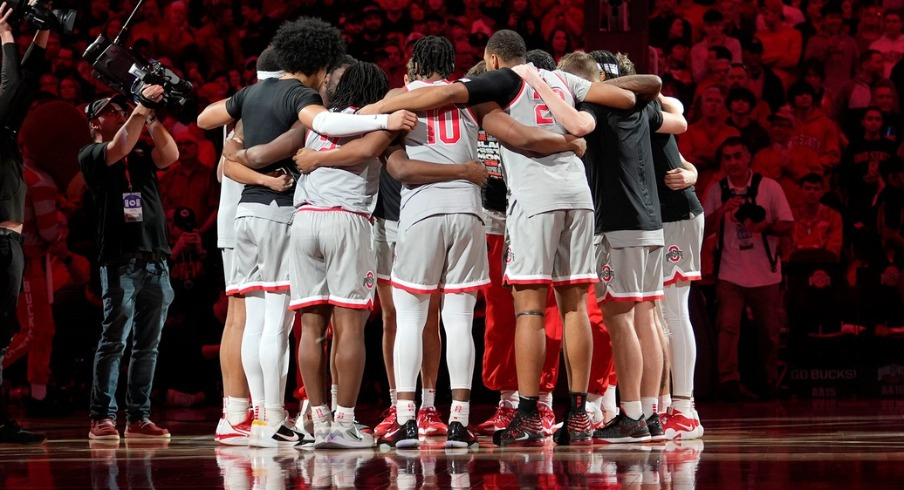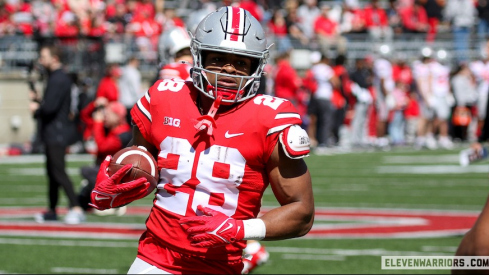The Buckeyes have their work cut out for them this offseason.
For Chris Holtmann to restore faith from the scarlet and gray fan base, Ohio State must quickly turn the page from what was its worst campaign in at least six years, if not several more. Returning to the NCAA Tournament will be an expectation after missing the Big Dance in 2022-23, and beyond that, Ohio State athletic director Gene told Eleven Warriors last month he wants the Buckeyes in contention for a Big Ten title, too.
For either of those goals to be a possibility in 2023-24, it’s no secret that Ohio State will have to make wholesale improvements in a hurry. Of course, the Buckeyes won’t look exactly the same in terms of personnel this season. Brice Sensabaugh is off to the NBA, Justice Sueing, Sean McNeil and Isaac Likekele will all pursue professional opportunities and Eugene Brown and Tanner Holden both hit the transfer portal. In turn, the Buckeyes brought in three new transfer portal additions and have a four-man freshman class entering the program.
But no matter who’s on the floor, the Buckeyes must get better in the coming months. So where should Ohio State focus its efforts? We dove into five key areas in which Ohio State struggled last season and why improved numbers in each category should yield more wins for the Buckeyes in the upcoming campaign.
Defensive efficiency
This past year marked the third in a row in which defense was largely Ohio State’s Achilles’ heal. While there are plenty of metrics one could point to in order to illustrate that notion, KenPom’s defensive efficiency rating paints a clear picture of the Buckeyes’ struggles on D.
| Year | Offense | Defense | Record |
|---|---|---|---|
| 2017-18 | No. 23 | No. 15 | 25-9 |
| 2018-19 | No. 84 | No. 25 | 20-15 |
| 2019-20 | No. 13 | No. 19 | 21-10 |
| 2020-21 | No. 4 | No. 82 | 21-10 |
| 2021-22 | No. 13 | No. 111 | 20-12 |
| 2023-24 | No. 19 | No. 106 | 16-19 |
Despite having the 19th-best offense in the nation in terms of efficiency last season, Ohio State finished 106th in defensive efficiency. And while that’s not the worst mark of Holtmann’s tenure in Columbus, 2022-23 was the second consecutive season in which the Buckeyes finished below at least 105 other Division I programs in that category.
In Holtmann’s first three seasons, Ohio State ranked no worse than 25th in the nation in defensive efficiency. The 2017-18 Buckeyes ranked 15th, the best mark in Holtmann’s OSU run, while the 2018-19 and 2019-20 teams finished 25th and 19th, respectively.
Since then, Ohio State’s numbers have tanked. The Buckeyes fell to 82nd in defensive efficiency in 2020-21, followed that up with the No. 111 spot in 2021-22, and barely improved their standing in another lackluster defensive season in 2022-23.
Ohio State gave up an average of 69 points per game this past season, more than all but four other teams in the Big Ten. The Buckeyes were also one of the five worst teams in the conference in opponent field-goal percentage as they allowed foes to hit 43% of their shots in 2022-23. Ohio State sent opponents to the free-throw line more than all but two teams in the conference, and only Indiana saw its adversaries hit more shots from the charity stripe than the scarlet and gray.
3-point attempts
Ohio State was an elite 3-point shooting team in the Big Ten last season. The Buckeyes hit 36.8% of their triples, which was better than every team in the conference besides Michigan State and Penn State. OSU’s percentage also ranked a respectable 45th in the NCAA.
It wasn’t the Buckeyes’ efficiency from three that hurt them, but their lack of attempts relative to how well they shot the ball from deep. Just four teams in the Big Ten shot fewer threes than the Buckeyes, who ranked 296th in the country in attempts from beyond the arc (650). For a team that shot the third-best percentage in the conference, eight other Big Ten teams knocked down more 3-pointers than the scarlet and gray in 2022-23.
Two seasons removed from a year in which Duane Washington hit a fraction under three 3-pointers per game for Ohio State, no Buckeye averaged more than 1.8 3-point makes a game this past season. Not to mention, Ohio State lost the two most active 3-point shooters on its roster over the offseason with both Sensabaugh and McNeil departing from the program.
Help is on the way from the 3-point line, though as Minnesota transfer forward Jamison Battle is a career 35% shooter from behind the line while attempting a whopping 7.1 threes per game in his collegiate tenure.
Welcome to Columbus @battletime510 The grind starts today #GoBucks pic.twitter.com/46Nxaiej8j
— Ohio State Hoops (@OhioStateHoops) June 6, 2023
Of course, if Ohio State isn’t as accurate from 3-point range this season, forcing up more shots won’t necessarily be beneficial. But if the Buckeyes shoot a similar percentage, they’d be wise to take advantage more than they did a year ago.
Getting to the FT line
Shooting more threes AND getting to the free-throw line more frequently may seem counterintuitive, but the numbers in the latter category simply can’t be ignored.
Ohio State ranked 305th in the country in free-throw attempts in 2022-23 and ninth in the Big Ten, shooting 29 fewer than its opponents overall despite shooting the fourth-best percentage in the conference. Ohio State hit nearly 74% of its free throws last season, but considering its low volume of attempts, it wasn’t the strength that it could have been.
In 2021-22, E.J. Liddell averaged 6.9 free-throw attempts per game by himself. This past season, no single Buckeye averaged even half as many. Ohio State’s average of 72.6 points per game ranked sixth in the Big Ten this season, but it was the Buckeyes’ lowest offensive output in three years.
If Ohio State can draw fouls more proficiently and continue to knock down free throws at an impressive rate, its offensive efficiency will only rise as a result.
Generating turnovers
One way Ohio State can boost its defensive performance in 2022-23 is by creating more turnovers, which it struggled to do last season.
The Buckeyes’ average of 5.2 steals per game was ninth in the Big Ten, but in the context of the rest of the country, that figure looks even worse. Ohio State ranked 301st in the NCAA as opponents rarely coughed up the ball to the Buckeyes.
Ohio State didn’t have a game with double-digit steals until March, when the Buckeyes appeared to make more of an effort to get their hands in passing lanes in a Big Ten Tournament matchup with Iowa. The effort paid off as Ohio State stole possessions from the Hawkeyes to earn a win and a spot in the quarterfinal round of the tournament.
The Buckeyes’ season steals average was actually their highest since the 2018-19 season, but there’s little doubt that continuing to increase that number will aid in efficiency on both ends of the floor in the coming campaign.
Moving the ball
Ohio State was the only team in the Big Ten that didn’t have a player who ranked in the top 20 performers in the conference in assists per game this past season.
Likekele, Ohio State’s average assists leader, dished just 2.8 per game as the Buckeyes finished 12th in the Big Ten with an average of 11.7. That number ranked 283rd in the country in 2022-23.
From the start of the season through Jan. 5, Ohio State averaged 14.2 assists per game, but that dwindled to 8.9 across the subsequent 14 games – a stretch in which the Buckeyes won just one game. But Ohio State’s ball movement increased significantly as it got things together down the stretch. The Buckeyes were .500 in the final 10 games of the season as they averaged 12 assists a night.
Those trends clearly illustrate that the more the Buckeyes move the ball on offense, the more success they have on the whole. While Sensabaugh’s ability to score in one-on-one situations was a strength for the Buckeyes last season, limiting stagnation could be key to more wins in 2023-24.


